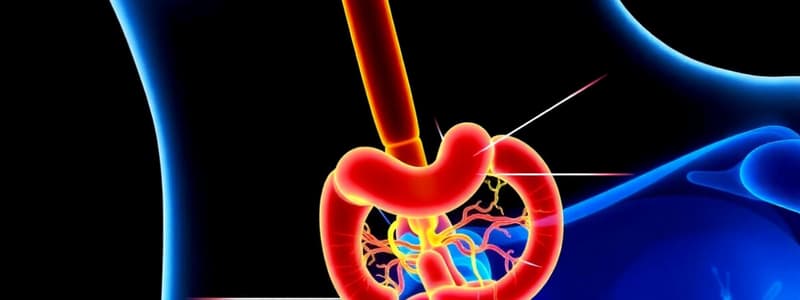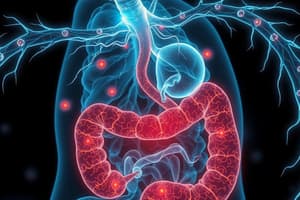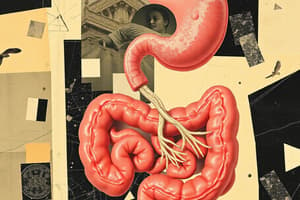Podcast
Questions and Answers
What is the primary role of sensory neurons in the enteric nervous system?
What is the primary role of sensory neurons in the enteric nervous system?
- Control motility of the GI tract
- Receive information from the mucosa (correct)
- Regulate secretion of digestive enzymes
- Relay information from motor to sensory neurons
Which plexus is responsible for controlling the motor function of the gastrointestinal tract?
Which plexus is responsible for controlling the motor function of the gastrointestinal tract?
- Plexus of Auerbach (correct)
- Submucosal Plexus
- Meissner’s Plexus
- Vagus Plexus
Which neurotransmitter is considered excitatory in the enteric nervous system?
Which neurotransmitter is considered excitatory in the enteric nervous system?
- GABA
- Serotonin
- Norepinephrine (NE)
- Acetylcholine (ACh) (correct)
What type of neurons in the enteric nervous system act on smooth muscle and endocrine/exocrine cells?
What type of neurons in the enteric nervous system act on smooth muscle and endocrine/exocrine cells?
What is the main function of Meissner’s Plexus in the gastrointestinal tract?
What is the main function of Meissner’s Plexus in the gastrointestinal tract?
Which neurotransmitter is released by inhibitory fibers in the enteric nervous system?
Which neurotransmitter is released by inhibitory fibers in the enteric nervous system?
What type of control does the autonomic nervous system (ANS) primarily exert on the gastrointestinal tract?
What type of control does the autonomic nervous system (ANS) primarily exert on the gastrointestinal tract?
How many types of neurons are contained within the enteric nervous system?
How many types of neurons are contained within the enteric nervous system?
What is the primary role of gastric juice in the stomach?
What is the primary role of gastric juice in the stomach?
Which enzyme initiates lipid digestion in the stomach?
Which enzyme initiates lipid digestion in the stomach?
What do parietal cells in the oxyntic glands secrete?
What do parietal cells in the oxyntic glands secrete?
In the stomach, salivary amylase is primarily inactivated by which condition?
In the stomach, salivary amylase is primarily inactivated by which condition?
What is the primary secretory function of G cells in the pyloric glands?
What is the primary secretory function of G cells in the pyloric glands?
What stimulates the waves of smooth muscle contraction in the digestive tract?
What stimulates the waves of smooth muscle contraction in the digestive tract?
At what interval does the duodenum have its slow waves compared to the ileum?
At what interval does the duodenum have its slow waves compared to the ileum?
What is the approximate membrane potential (mV) required for an action potential in intestinal smooth muscle?
What is the approximate membrane potential (mV) required for an action potential in intestinal smooth muscle?
Which of the following mechanical functions does the stomach perform?
Which of the following mechanical functions does the stomach perform?
Which part of the digestive tract has the slowest frequency of slow waves?
Which part of the digestive tract has the slowest frequency of slow waves?
What role do gap junctions play in smooth muscle contraction?
What role do gap junctions play in smooth muscle contraction?
What happens to membrane potential during stimulation by the sympathetic nervous system in smooth muscle?
What happens to membrane potential during stimulation by the sympathetic nervous system in smooth muscle?
Which of the following is NOT a function of the stomach?
Which of the following is NOT a function of the stomach?
What is the primary function of receptive relaxation in the stomach?
What is the primary function of receptive relaxation in the stomach?
Which nervous system primarily controls gastric accommodation and dilation of the proximal stomach?
Which nervous system primarily controls gastric accommodation and dilation of the proximal stomach?
What happens when the vagus nerve is transected?
What happens when the vagus nerve is transected?
Where do contractions in the stomach primarily begin?
Where do contractions in the stomach primarily begin?
What role does the pyloric sphincter play in gastric emptying?
What role does the pyloric sphincter play in gastric emptying?
What is the relationship between volume and pressure in the stomach during receptive relaxation?
What is the relationship between volume and pressure in the stomach during receptive relaxation?
What does the spontaneous electrical rhythm in the distal stomach facilitate?
What does the spontaneous electrical rhythm in the distal stomach facilitate?
What occurs during the contractions as they approach the pyloric sphincter?
What occurs during the contractions as they approach the pyloric sphincter?
What primarily causes the emptying of the stomach?
What primarily causes the emptying of the stomach?
How does the fed state affect stomach contractions?
How does the fed state affect stomach contractions?
Which hormone is associated with increasing gastric contractions?
Which hormone is associated with increasing gastric contractions?
What factor most influences the time food spends in the stomach?
What factor most influences the time food spends in the stomach?
Which of the following mechanical stimuli can increase contractions in the stomach?
Which of the following mechanical stimuli can increase contractions in the stomach?
Which physiological state does the stomach exhibit prominent contractions?
Which physiological state does the stomach exhibit prominent contractions?
Which of the following is a primary factor that triggers hormone release affecting gastric motility?
Which of the following is a primary factor that triggers hormone release affecting gastric motility?
In which phase does the stomach generally remain quiescent?
In which phase does the stomach generally remain quiescent?
What effect does the sympathetic nervous system primarily have on gastrointestinal motility?
What effect does the sympathetic nervous system primarily have on gastrointestinal motility?
Which neurotransmitter is primarily responsible for the excitatory control of gastrointestinal motility?
Which neurotransmitter is primarily responsible for the excitatory control of gastrointestinal motility?
Which of the following statements accurately describes the physiological antagonism between the sympathetic and parasympathetic nervous systems in the GI tract?
Which of the following statements accurately describes the physiological antagonism between the sympathetic and parasympathetic nervous systems in the GI tract?
What is the main source of innervation for the lower gastrointestinal tract?
What is the main source of innervation for the lower gastrointestinal tract?
How does the sympathetic nervous system primarily influence the secretion of gastrointestinal glands?
How does the sympathetic nervous system primarily influence the secretion of gastrointestinal glands?
Which component primarily activates gastric lipase in the stomach?
Which component primarily activates gastric lipase in the stomach?
What primary role does gastrin serve in the gastrointestinal system?
What primary role does gastrin serve in the gastrointestinal system?
Which cells in the oxyntic glands secrete intrinsic factor critical for vitamin B12 absorption?
Which cells in the oxyntic glands secrete intrinsic factor critical for vitamin B12 absorption?
What is the primary composition of gastric juice secreted by the stomach?
What is the primary composition of gastric juice secreted by the stomach?
Which of the following best describes the process of digestion initiated in the stomach?
Which of the following best describes the process of digestion initiated in the stomach?
What is the role of inter-neurons in the enteric nervous system (ENS)?
What is the role of inter-neurons in the enteric nervous system (ENS)?
Which of the following correctly describes the location of the Plexus of Auerbach?
Which of the following correctly describes the location of the Plexus of Auerbach?
Which type of neuron primarily controls the secretion of the mucosa in the enteric nervous system?
Which type of neuron primarily controls the secretion of the mucosa in the enteric nervous system?
What kind of control does the autonomic nervous system (ANS) exert over the enteric nervous system?
What kind of control does the autonomic nervous system (ANS) exert over the enteric nervous system?
Which neurotransmitter is released by excitatory fibers in the enteric nervous system?
Which neurotransmitter is released by excitatory fibers in the enteric nervous system?
What is the primary function of Meissner’s Plexus?
What is the primary function of Meissner’s Plexus?
Which statement accurately depicts the organization of the enteric nervous system (ENS)?
Which statement accurately depicts the organization of the enteric nervous system (ENS)?
Which of the following best describes the relationship between the enteric nervous system and the autonomic nervous system?
Which of the following best describes the relationship between the enteric nervous system and the autonomic nervous system?
What primarily influences the time food spends in the stomach?
What primarily influences the time food spends in the stomach?
Which hormone is responsible for decreasing contractions in the stomach?
Which hormone is responsible for decreasing contractions in the stomach?
What mechanism is responsible for the coordinated emptying of the stomach?
What mechanism is responsible for the coordinated emptying of the stomach?
Which of the following factors does NOT directly affect gastric motility?
Which of the following factors does NOT directly affect gastric motility?
What physiological process primarily involves the relaxation of the stomach to maintain stable intraluminal pressure despite increased volume?
What physiological process primarily involves the relaxation of the stomach to maintain stable intraluminal pressure despite increased volume?
What occurs in the stomach during the cephalic phase?
What occurs in the stomach during the cephalic phase?
How do intestinal receptors influence gastric emptying?
How do intestinal receptors influence gastric emptying?
What happens to the ability of the stomach to distend when the vagus nerve is transected?
What happens to the ability of the stomach to distend when the vagus nerve is transected?
During mixing and emptying in the stomach, where do contractions primarily begin?
During mixing and emptying in the stomach, where do contractions primarily begin?
Which condition best describes the state of the stomach in the fasted state?
Which condition best describes the state of the stomach in the fasted state?
What role does the pyloric sphincter play in gastric physiology?
What role does the pyloric sphincter play in gastric physiology?
What effect does the narrow pyloric sphincter have on gastric emptying?
What effect does the narrow pyloric sphincter have on gastric emptying?
What neurotransmitter is suggested to play a role in the process of receptive relaxation in the stomach?
What neurotransmitter is suggested to play a role in the process of receptive relaxation in the stomach?
Which system is primarily responsible for the regulation of gastric accommodation and proximal stomach dilation?
Which system is primarily responsible for the regulation of gastric accommodation and proximal stomach dilation?
What is the primary outcome of the contractions that occur as they approach the pyloric sphincter?
What is the primary outcome of the contractions that occur as they approach the pyloric sphincter?
What is the relationship between volume and pressure in the stomach during receptive relaxation?
What is the relationship between volume and pressure in the stomach during receptive relaxation?
Flashcards are hidden until you start studying
Study Notes
Control of the GI Tract
- GI tract control is a combination of neural and hormonal factors.
- The enteric nervous system (ENS) provides intrinsic control.
- The autonomic nervous system (ANS) provides extrinsic control.
- Intrinsic factors include the ENS, and extrinsic factors include the ANS and GI hormones.
Enteric Nervous System (ENS)
- The ENS is contained entirely within the GI tract.
- It has three types of neurons: sensory, motor, and interneurons.
- Sensory neurons receive information from the mucosa.
- Motor neurons control motility and secretions.
- Interneurons relay information from sensory to motor neurons.
- Two plexuses, the myenteric (Auerbach's) and submucosal (Meissner's) plexuses, are responsible for controlling specific GI actions.
- The myenteric plexus controls motor function.
- The submucosal plexus controls the secretion of the mucosa.
Extrinsic Control by the ANS
- The ANS plays a role in controlling GI function.
- The parasympathetic nervous system (PNS) stimulates GI activity.
- The sympathetic nervous system (SNS) inhibits GI activity.
Smooth Muscle Slow Waves
- Slow waves of smooth muscle contraction are triggered by the Interstitial Cells of Cajal (ICCs).
- ICCs are between the circular and longitudinal smooth muscle layers.
- Slow waves cycle through depolarization that doesn't reach threshold.
- These slow waves, initiated by ICCs, are passed to smooth muscle through gap junctions.
- The frequencies of slow waves in different GI sections vary.
The Stomach - Regions
- The stomach has three regions: the oesophagus, proximal stomach (orad), and distal stomach (caudad).
- The pyloric sphincter regulates flow between the stomach and the duodenum.
Gastric Motor Function
- The stomach's function involves storage of ingested food, mixing contents, and emptying into the intestines.
- Receptive relaxation, a vagovagal reflex, relaxes the lower esophagus and proximal stomach, allowing for increased volume without pressure increase.
Mixing & Emptying
- The distal stomach shows spontaneous electrical rhythm.
- Contractions begin in the mid-stomach and spread distally, with the force and speed increasing as they reach the pyloric sphincter.
- This creates mixing, resulting in small amounts of food being emptied with each contraction, while most is pushed back for the next wave.
Factors Affecting Contractions
- Gastric contractions change with the presence of food.
- Neurohumoral and mechanical stimuli, such as distension, ACh, gastrin, and secretin, impact contractions.
Emptying
- Emptying is due to coordinated contractions and relaxation.
- The time spent in the stomach depends on the composition of food. Liquids empty quicker than solids.
- Composition of food entering the duodenum activates intestinal receptors, triggering hormone release, which in turn affects gastric motility and emptying.
Gastric Juice
- The stomach secretes gastric juice, composed mainly of water with HCl, HCO3-, Na+, K+, mucous, and pepsin.
- Gastric juice is vital for digestion in the stomach and includes swallowed saliva and refluxed duodenal fluids.
Gastric Digestion
- Digestion breaks down macromolecules into smaller, more absorbable components.
- Carbohydrate digestion starts in the mouth and continues in the stomach with gastric lipase, which is activated by low pH.
- Protein/peptide digestion begins with pepsin, activated by low pH.
Gastric Glands
- The stomach contains pyloric and oxyntic glands.
- Surface epithelial cells secrete mucous and HCO3- for lubrication and protection.
- Pyloric glands are located in the antrum and contain mucous cells, gastrin (G cells), and somatostatin (D cells).
- Oxyntic glands are in the fundus and body, containing oxyntic or parietal cells, which secrete HCl and intrinsic factor.
Enteric Nervous System (ENS)
- Located entirely within the GI tract
- Contains sensory, motor, and inter-neurons
- Sensory neurons detect information from the mucosa (muscle stretch, chemical nature)
- Motor neurons control motility and secretions (smooth muscle, endocrine/exocrine cells)
- Inter-neurons relay information between sensory and motor neurons
- Organized into two plexuses:
- Plexus of Auerbach (Myenteric Plexus): Located between the longitudinal and circular smooth muscle, controlling motor function
- Meissner's Plexus (Submucosal Plexus): Located in the submucosa, controlling mucosal secretions
- Contains excitatory fibers (releasing acetylcholine) and inhibitory fibers (releasing nitric oxide or vasoactive intestinal peptide)
Extrinsic Control by the ANS
- Sympathetic Nervous System:
- Originates from the prevertebral ganglion
- Post-ganglionic fibers synapse with both plexuses, also directly innervate GI smooth muscle/glands
- Primarily releases norepinephrine, decreasing motility and secretions
- Parasympathetic Nervous System:
- Vagus nerve (upper GI) and pelvic nerve (lower GI)
- Contains sensory afferents and pre-ganglionic efferents innervating the plexuses
- Releases acetylcholine, increasing contractions and secretions
- Represents physiological antagonism of norepinephrine - "rest and digest"
Receptive Relaxation
- Occurs during swallowing, relaxing the lower esophagus and proximal stomach.
- Facilitated by the vagovagal reflex, releasing nitric oxide to stabilize intraluminal pressure despite increased volume.
- Gastric accommodation and dilation of the proximal stomach also accommodate increased volume without pressure increase.
- Controlled by the enteric nervous system, with a marked increase in pressure beyond certain volumes.
Mixing & Emptying
- Distal stomach: Has spontaneous or basal electrical rhythm, similar to the small intestine.
- Contractions: Begin mid-stomach and spread distally, increasing in force and speed towards the pyloric sphincter/gastroduodenal junction.
- Effect: Contractions overtake stomach contents, emptying a small amount due to the narrow pyloric sphincter, while most content is pushed back for the next wave (mixing).
Factors Affecting Contractions
- Fasted state: Stomach is quiescent, depending on the phase (e.g., cephalic phase).
- Fed state: Contractions are fairly continuous.
- Control: Controlled by various neurohumoral and mechanical stimuli:
- Mechanical stimuli: Distension
- Acetylcholine (vagus): Increase number and force of contractions
- Gastrin: Increases contractions
- Secretin: Decreases contractions
Emptying
- Mechanism: Coordinated contraction: peristaltic contractions in the stomach, relaxed pylorus, and lack of contraction in the duodenum.
- Time in stomach: Depends on composition:
- Liquid empties quickly
- Solids require size reduction, taking longer in the stomach
- Duodenal regulation: Composition of food entering the duodenum activates intestinal receptors, releasing hormones that alter gastric motility and emptying (acidic, lipid, osmotic pressure).
Gastric Juice
- Secretion: ~1,500 ml/day
- Composition: Predominantly water, also includes HCl, HCO3-, other ions, mucous, and pepsin.
- Includes swallowed saliva and refluxed duodenal fluids (bile, pancreatic juice).
- Mediates digestion in the stomach.
Gastric Digestion
- Carbohydrates: Digestion begins in the mouth with salivary amylase, largely inactivated by the acidic stomach.
- Lipids: Digestion begins in the stomach with gastric lipase, activated by the low stomach pH.
- Proteins/peptides: Digestion starts in the stomach with pepsin, activated by low pH from inactive precursor pepsinogen.
Gastric Glands (Pyloric & Oxyntic)
- Surface epithelial cells (throughout stomach): Secrete thick mucous with mucin and HCO3-, lubricates and protects against low pH and enzymes.
- Pyloric glands (antrum of stomach):
- Predominantly mucous cells
- Gastrin (G cells): Secretes gastrin, a peptide hormone released into the blood (endocrine function)
- Somatostatin (D cells): Secretes somatostatin, a peptide hormone with endocrine and paracrine actions.
- Oxyntic glands (fundus and body):
- Oxyntic or Parietal cells: Secrete HCl (kills bacteria, lowers pH for digestion) and intrinsic factor (vitamin B12 absorption).
Studying That Suits You
Use AI to generate personalized quizzes and flashcards to suit your learning preferences.




